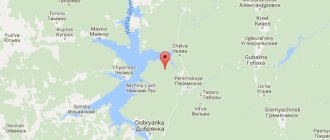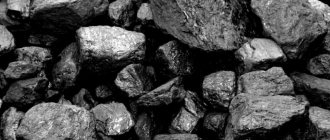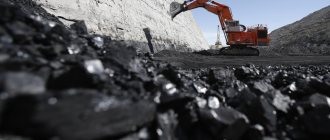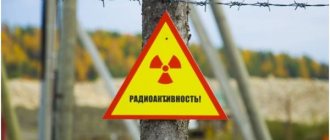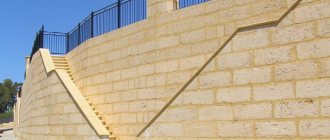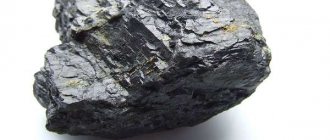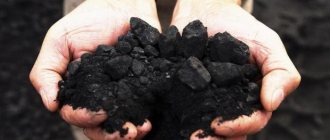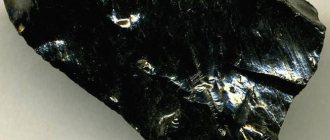Coal is a solid combustible mineral that has been used by humans for heating rooms since ancient times. In addition, hard coal is successfully used in various industries. In the article we will briefly present information about the properties of coal, a description of its types, methods of extraction and use.
Types of coal
There are three types of coal. All of them lie in layers in the bowels of the Earth.
1. Anthracite. This type is very hard in structure and has the highest combustion temperature. Deposits of this coal are located very deep underground.
2. Coal. This is the most common type of coal in human activity. It is used to heat stoves, and artificial graphite, liquid fuel, paints, and lubricating oils are obtained from it. It is mined both open-pit and closed in mines.
3. Brown coal. The variety was formed from peat residues later than all others, so it is considered the youngest. Its peculiarity is that it has a very low combustion temperature.
Properties
Coal differs in the following properties:
- Density. This is one of the most important characteristics, which ranges from 1.28 to 1.53 grams per cubic centimeter. As density values increase, the specific heat of combustion of coal increases.
- Carbon content. This figure ranges from 75 to 97 percent. With a higher carbon content in the fuel, there is less volume for foreign impurities. This allows you to obtain the maximum amount of energy during combustion of the product.
- Mechanical strength. This characteristic determines the fossil's ability to withstand transportation. This parameter ranges from 40 kilograms per square centimeter (for brown coals) to 300 (for anthracites).
- Sulfur content. In coal it can be from 0.5 to 5.4 percent. With a lower value of this value, it is safer to use fuel.
- Yield of volatile components (2-45%).
- Humidity. Fuel can contain from 4 to 15 percent moisture. This indicator directly determines whether coal is effective when burned. The properties of a wetter product are fundamentally different from those of a dry product. Such coal crumbles and undergoes rapid weathering.
- Ash content. This characteristic indicates the amount of non-flammable mixtures contained in the fossil. With lower ash content, the specific heat capacity increases. Anthracite has the lowest percentage of non-flammable mixtures. It is within 2%. For heating, ash content within thirty percent is acceptable. The highest value of this characteristic is 45%.
- Specific heat of combustion. This figure ranges from 6500 to 8600 kcal/kg. It characterizes the amount of heat that is generated during the combustion of one kilogram of fuel.
Coal mining methods
How deep underground the layers are will directly affect how it is extracted. There are only two ways:
- The open method is used when the rock is not deep. Before starting mining, the soil is analyzed for hardness, it is determined how weathered the soil is and the thickness of the covering layer. Based on this, digging equipment is brought in. Bulldozers and scrapers are used to dig up soft soil. Excavators and draglines for thick layers. They produce an explosion of a thick layer of rock.
- The closed method is used when the coal is deep. Adits and mines are built for mining. If the depth reaches more than 45 meters, mine shafts are built. Adits lead from it - horizontal tunnels.
This method has two systems for extracting minerals: longwall faces or room-and-pillar. The second system is less economical. The first is much safer and more effective. Thanks to it, it is possible to extract up to 79 percent of coal and deliver it evenly to the surface.
Volga class
Granite is a rock consisting of grains of several minerals. These are mainly feldspar, quartz and mica. Colored grains are feldspar (can be gray, pink, red), translucent, sparkling - quartz, black - mica. The word “granite” comes from the word “granum” - translated as “grain”, that is, granite consists of individual grains - crystals of quartz, mica and feldspar, which are components of granite. The color of granite depends on the feldspar. These components fit tightly together. Granite is formed in mountainous regions, in the depths of the earth. Very durable. Polishes well. Used in construction as a facing material. In addition, granite has low water absorption and high resistance to frost and dirt. That is why it is optimal for paving both indoors and outdoors. In the interior, granite is also used for finishing walls, stairs, creating countertops and columns.
Limestone is usually a white, gray or yellowish stone. It was formed from the remains of marine organisms. Their imprints can be clearly seen in limestone-shell rock. Limestones lie in the ground in huge layers. Limestones include the familiar chalk, common limestone and marble. A special type of limestone is chalk, the softest limestone. They write on the blackboard with chalk. Marble is a hard, dense stone of various colors that can be polished well. Marble is used to decorate buildings. Formed from the remains of tiny and larger marine organisms. Most often it is a white or light gray stone, consisting of small particles held together. Under the influence of acetic acid, it boils, bubbles form on its surface, and a hissing sound is heard. Sedimentary rock of organic origin, consists mainly of shells of marine animals and their fragments of shell rock. The substances that make up limestone can, although in small quantities, dissolve in water. When decomposed, it contributes to the formation of karst caves, and also at great depths under the influence of the deep heat of the earth, it provides a source of gas for mineral waters. Limestone was widely used as a building material, and fine-grained varieties were used to create sculptures. It is used in construction: for preparing mortars, for whitewashing premises, for cladding buildings, for finishing sidewalks.
Coal is black, hard, opaque, dense, but brittle. Formed from the remains of plants that existed millions of years ago. Flammable Used as fuel. Medicines are made from coal tar. The method of coal mining depends on the depth of its occurrence. Mining is carried out by open-pit mining in open-cast coal mines if the depth of the coal seam does not exceed 100 meters. There are also frequent cases when, with an ever-deepening coal mine, it is further profitable to develop a coal deposit using the underground method. Mines are used to extract coal from great depths. The deepest mines in the Russian Federation extract coal from a level of just over 1200 meters. The uses of coal are varied. It is used as a household fuel, energy fuel, and raw material for the metallurgical and chemical industries. The liquefaction of coal to form liquid fuel is very promising. To produce 1 ton of oil, 2–3 tons of coal are consumed; for example, South Africa almost completely provided itself with fuel thanks to this technology. Artificial graphite is obtained from coal. Coal is also used as an ornamental stone. Fragile coal that shines in the sun is not something everyone can handle.
Clay can be white, red, brown, gray. Opaque, hard, friable, plastic, non-flammable. Porcelain, earthenware, and refractory materials are produced from different types of clay. Clay is a sedimentary rock. It, like sand, is formed as a result of the weathering of various rocks, but is deposited at the bottom of seas and lakes. Formed during the destruction of various rocks, such as granite. Clay consists of small particles, similar to scales, strongly bonded to each other. Therefore, clay, unlike sand, cannot be poured over. Raw clay has a binding property. When mixed with water, clay forms a dough-like mass suitable for further processing. Depending on the place of origin, natural raw materials have significant differences. One can be used in its pure form, the other must be sifted and mixed to obtain a material suitable for the manufacture of various products: bricks, tiles, dishes. Products made from fired clay are called ceramic. Technical ceramics is a large group of ceramic products and materials obtained by heat treatment of a mass of a given chemical composition from mineral raw materials and other high-quality raw materials that have the necessary strength and electrical properties. Cement production. Clay is used in medicine, for example, clay is part of some medicinal ointments and antidiarrheal agents. In cosmetics, clay is the basis of masks and some ointments. Healing clays and muds are widely used in spa treatment of skin, gynecological diseases, and diseases of the musculoskeletal system. White clay can be used as an antidote due to its sorbent properties (macaws are known for eating clay as an antidote to poisonous bones, which they are very fond of).
Sand is a loose rock consisting of mineral particles ranging in size from 2 mm to five hundredths of a millimeter. Its color varies - black, greenish, reddish; yellow and white sand are most common. Sand is a product of the destruction of hard rocks under the influence of sun, wind, and water. Most often, sand is formed from quartz. Its veins pierce granite, mica, dolomite, feldspar and other rocks. Typically, sand contains the most quartz. Due to its presence, sand is indispensable in glass production. Millions of tons of sand are used in foundry and metal melting. And you can’t make a brick without sand. Used in construction.
Iron ore is black, hard, dense, and opaque. A special property is fusibility. Metals are smelted from it.
Oil is liquid, dark, opaque, with a pungent odor. Fuel is made from it - gasoline, kerosene, engine oil; Vaseline, medications. Lies deep in the ground. To extract it, people build drilling rigs, drill deep wells into which pipes are lowered. Then it travels through special overpasses to places of processing and consumption. Huge reserves of oil and gas lie on the seabed. Oil occupies a leading place in the global fuel and energy balance. Due to the rapid development of the chemical and petrochemical industries in the world, the need for oil is increasing not only to increase the production of fuels and oils, but also as a source of valuable raw materials for the production of synthetic rubbers and fibers, plastics, dyes, etc. What would our civilization become? , if humanity suddenly lost its black gold? First of all, we would have to give up the car - after all, gasoline, without which the “iron horse” could not run, is made from oil. And not only that - almost any modern vehicle, with the exception of electric ones, uses petroleum products as fuel. Cars and motorcycles need gasoline, airplanes need aviation gasoline or kerosene, tractors, combines need diesel fuel, ships need fuel oil. There will also be no place for the usual asphalt highways in a world without oil, because asphalt is made from the residues formed during its distillation. So instead of highways with cars racing along them, in a world without oil there will be sloppy country roads without asphalt pavement, along which you will have to drive a cart with a horse harnessed to it. Printing inks are made from oil, which means that without oil there will be no magazines, newspapers, or books. We wouldn’t have a movie either, because there would be no more photographic and film films, which are also made from oil. And it would not be possible to record anything on digital media, since they are also a product of oil refining. A world without books, newspapers, magazines, television, photography - that’s what a world without oil is. For modern fashionistas, the lack of oil would also be a blow. It is actively used in the manufacture of cosmetics and perfumes, so one would have to say goodbye to lipstick, mascara, eau de toilette, and fashionable hair dyes. Nylon tights, elastic underwear, faux fur coats, fashionable jackets made of nylon and other synthetic fabrics - all this would also disappear from store windows. And in everyday life, modern people simply cannot take a step without oil! Oil is plastic bottles and plastic bags, which have become firmly established in our everyday life, shopping bags, threads, fishing line, and plasticine. And finally, these are various plastics from which furniture, household appliances, computers and much more are made. The modern world is a world created from oil in the most literal sense of the word.
Reports, messages, abstracts. The world. 3rd grade
4.3 / 5 ( 515 votes)
BUY GOODS OR GOODS WITH DELIVERY (NOT FOR ALL REGIONS) TO YOUR HOME
Large coal deposits
A coal basin is a place where coal lies. There are over 3.5 thousand coal mines around the world. The total area of all basins occupies 14.9% of the earth's land. The country with the most coal deposits is the United States. The world reserve there is 23%. The next country is Russia, which has about 13% of the world's supply. With 11 percent, the next third leader is China. In the United States, the Appalachian Basin has the largest deposits in the entire world. 1600 billion tons are the reserves of this field.
In our country, the largest pool is Kuznetsky. Location: Kemerovo region. Its reserves amount to about 640 billion tons.
Homework assignments
Think about whether your family uses any minerals or mineral products in their household. If yes, which ones and for what purpose?
Our family uses:
Table salt for cooking. Plastics, oils, gasoline for cars are used - these are products of oil refining. We use metal utensils and tools - these are products of processing iron and non-ferrous ores. We use pencils with graphite leads. We use electronics, electrical wiring, electrical appliances that use copper, aluminum, silicon, gold, silver. We use glass, which is a product of sand and quartz processing. Even our house is made of brick, cement, concrete, iron.
In the local history museum, get acquainted with the section about the minerals of your region and their processing. Which enterprises in your region process them? What do they produce?
There are many iron ore deposits in our region. It is processed at metallurgical enterprises and factories. There, iron ore is first used to produce cast iron, then steel, from which many useful things are made.
And also in our region there are oil deposits, which are processed at chemical plants, where they produce plastic, fabrics, medicines, gasoline, and household chemicals.
In the book “The Giant in the Clearing,” read the story “And the Stone Is Worthy of Respect.” Analyze your behavior in nature. What can this story teach you?
This story teaches us to take care of inanimate objects, in particular stones and rocks. Stones and boulders are witnesses of ancient glaciation; they are part of the history of our region. The rocks are beautiful in themselves, and different inscriptions on them only spoil this pure natural beauty.
Coal use
The area of use of minerals is huge
- Pigs, sulfur, vanadium, and zinc are extracted from it.
- It is used as fuel.\
- Used for smelting metals.
- Coal produces substances that are necessary for the production of varnishes and paints, as well as other products - benzene and xylene.
- It is burned to produce liquid fuel.
Today, as a result of chem. processing, produce more than 400 different types of industrial products.
Classification by size
When choosing coal, it is important to know its size. This indicator is encrypted in the mineral grade. So, coal can be:
- “P” – slab, which consists of large pieces over 10 cm.
- “K” – large, the dimensions of which range from 5 to 10 cm.
- “O” is a nut, it is also quite large, with fragment sizes from 2.5 to 5 cm.
- “M” – small, with small pieces of 1.3-2.5 cm.
- “C” - seed - a cheap fraction for long-term smoldering with dimensions of 0.6-1.3 cm.
— “Ш” – a piece, which is mostly coal dust, intended for briquetting.
— “R” – ordinary, or non-standard, in which there can be factions of various sizes.
Report Coal Minerals Post
Natural minerals such as coal have been used from ancient times to the present day as an essential fuel. Its characteristic color ranges from black to gray-black, otherwise a glossy sheen predominates. The size and shape of the predominant coal varies from small to large size.
How is coal formed?
Its beginning lies deep underground. And the beginning of the formation of coal occurred due to the remains of ancient plants that were very deep underground, this was more than 300 million years ago. Since the plants were located under a thick layer of soil without air supply and were exposed to rather high temperatures, these plants gradually began to take on the appearance of peat. After quite some time, the peat lost moisture and gas, was pressed, and gradually acquired the appearance and properties of coal.
What is coal made of?
Coal contains carbon, hydrogen, oxygen, ash and sulfur. Coal, although it looks quite strong, is very fragile and easily breaks into small pieces. In order for coal to reach people, it will take a lot of effort and time.
If the coal is not located deep underground, but one can say that it is on the surface, then it could be mined on the surface without being loaded underground. It is removed using special equipment. And if the coal is located at a depth of more than one kilometer, then in this case it is mined using underground mines, where, with the help of miners, the coal is extracted and sent for sale for its further intended use.
Drawing a conclusion, we can say that such a natural resource as coal is very valuable and necessary. It is used in domestic conditions for heating many premises, as well as state enterprises, and this fossil is also used in metallurgy and the chemical industry. This black gold is simply irreplaceable for humanity.
3, 4, 5 grade, the world around us
How was coal formed?
Coal is a rock, a solid mineral, formed from the decomposed remains of animals and plants. Refers to exhaustible non-renewable natural resources, that is, those that are not restored or whose recovery rate is very low.
Coal appeared on the planet about 350 million years ago, when huge tree ferns and gymnosperms grew in ancient swamps. Dying, they sank to the bottom of the reservoir, crushed by the thickness of the water. This is how peat was formed, which, under further centuries-old pressure from water and other organic matter, gradually turned into coal.
Rice. 1. Coal deposits.
The main reserves of coal date back to the Paleozoic era, when the planet was inhabited by dinosaurs and giant plants. The abundant vegetation of that era contributed to a more intensive formation of natural combustible substances.
Popular message topics
- System of additional education
Additional education of children is formed actions aimed at the development of the child. Auxiliary (optional) education of children is implemented through multidirectional additional classes, - Daisy
Daisy is a perennial plant, a member of the Asteraceae family. In total, this genus includes 14 species, of which only a few grow in Russia (the western part and the Caucasus); most species grow in Europe, - Dokuchaev Vasily Vasilievich
Dokuchaev Vasily Vasilievich is a great Russian scientist, geographer. He lived and studied soils on our Earth. He created the science of soil science. Dokuchaev was born into a large family of a priest. He had four sisters and two brothers.
